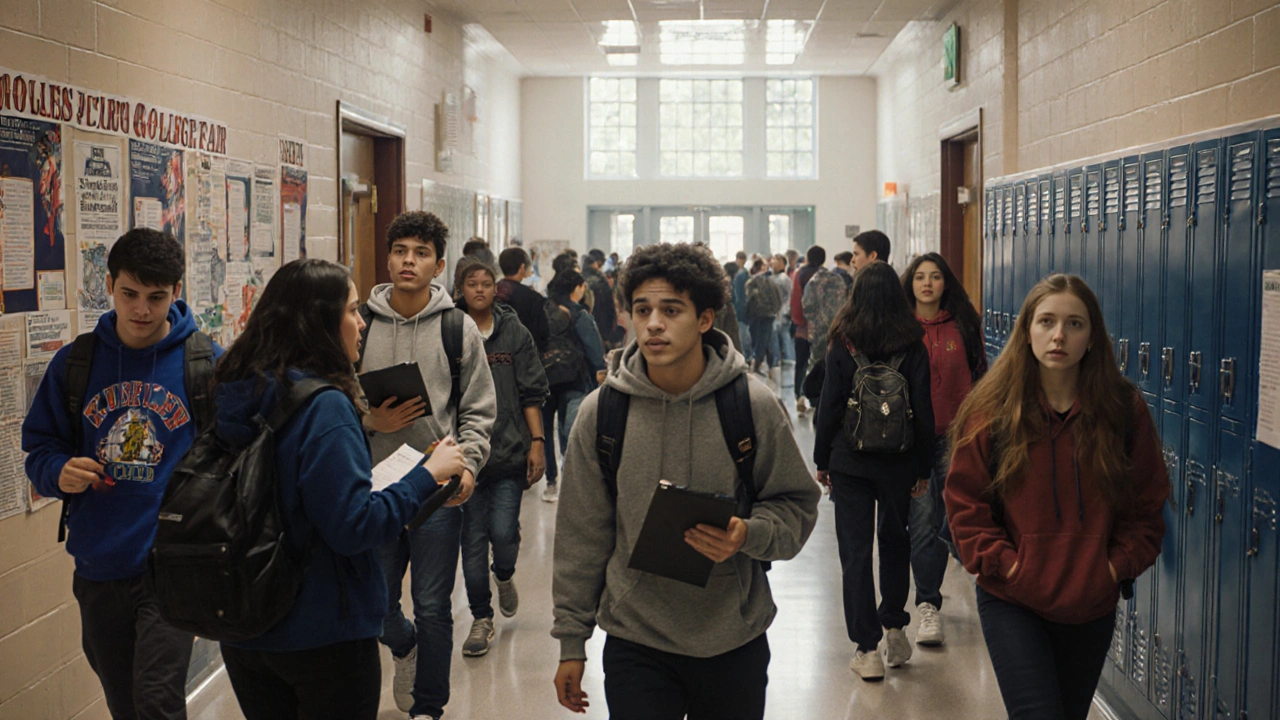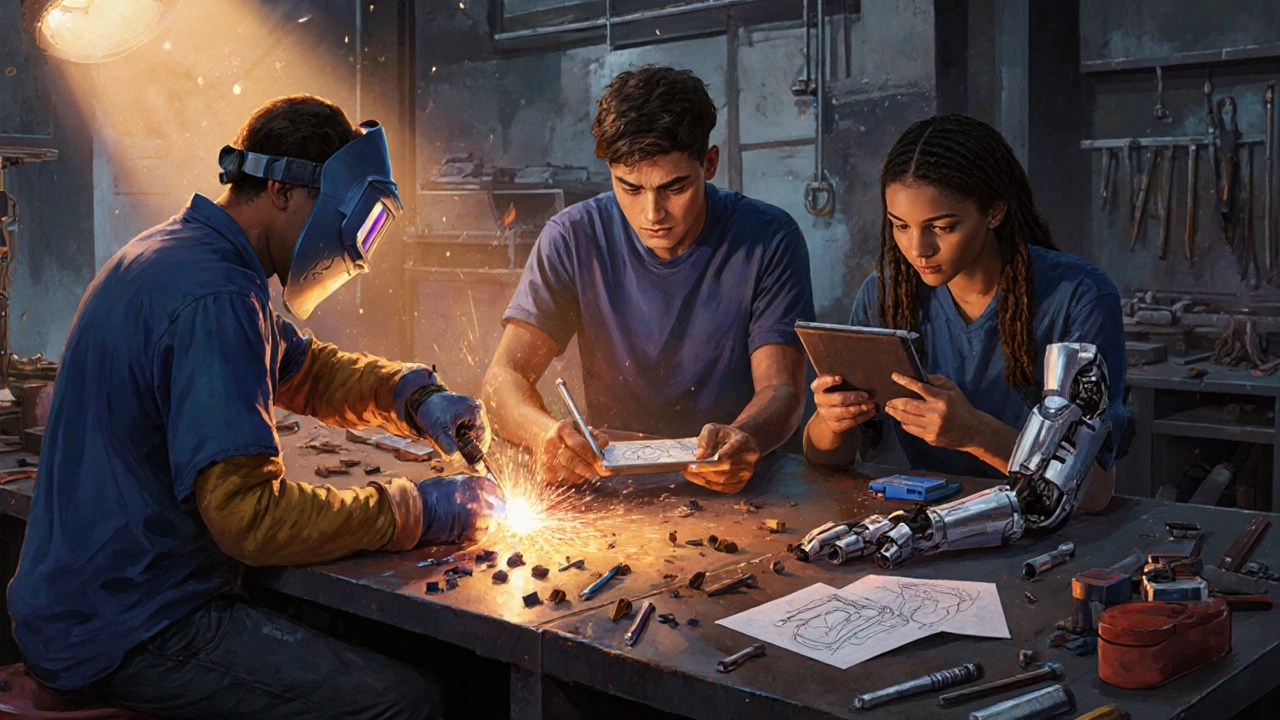Exploring the World of High Schools: An Inside Look

Most people remember high school as a blur of lockers, lunch lines, and last-minute cram sessions. But if you step back and really look, high schools today are complex ecosystems - part classroom, part social lab, part career launchpad. They’re not just places where teens learn math and science. They’re where identities form, friendships solidify, and futures begin to take shape - often in ways no curriculum ever planned for.
What High School Really Looks Like Inside
Walk into any American high school on a Tuesday morning and you’ll see the same basic rhythm: bells, hallways packed with teens in hoodies and backpacks, teachers calling out names from attendance sheets. But beneath that routine, there’s a lot more going on. The average U.S. high school serves about 850 students, with class sizes hovering around 25. That’s enough for a tight-knit community - but also enough for students to feel lost if they don’t find their niche.
Some schools have 30+ AP and honors courses. Others barely offer beyond Algebra II. In Chicago Public Schools, nearly 60% of students take at least one dual-enrollment class with a local college. That’s not just a perk - it’s a lifeline for kids who can’t afford to pay for college credits later. Meanwhile, in rural districts, students might drive 45 minutes just to get to a school with a robotics club.
Curriculum isn’t one-size-fits-all anymore. A student in Austin might be coding in Python for a digital media project. A kid in Ohio could be learning welding in a career and technical education (CTE) lab. And in New York City, some high schools now require students to complete a capstone project - like designing a community garden or interviewing local business owners - before graduation.
The Hidden Curriculum: More Than Just Grades
Textbooks teach biology. But the real lessons? They come from who sits next to you in homeroom, who gets picked last for the basketball team, who gets ignored during group projects. High school is where social hierarchies get forged - and sometimes broken.
Studies from the University of Chicago show that students who feel connected to their school are 3x more likely to graduate. That connection doesn’t come from perfect test scores. It comes from being asked how your mom’s doing after surgery. From a teacher staying after school to help you fix your college essay. From the cafeteria worker who remembers your name and always gives you an extra apple.
And then there’s the pressure. Mental health visits in high schools jumped 40% between 2020 and 2024, according to the CDC. Schools are now hiring counselors at a 1:250 ratio - still far below the recommended 1:250. Many students don’t speak up until they’re drowning. That’s why some schools now run peer support circles, where students lead weekly check-ins without adult supervision. It’s not therapy. But it’s something.

Extracurriculars: Where Real Skills Are Built
Forget the myth that clubs are just resume padding. Debate team teaches you how to think on your feet. Theater teaches you how to listen. Robotics teaches you how to fail - and try again. A 2023 study by the National Association of Secondary School Principals found that students involved in two or more extracurriculars were 20% more likely to report high levels of self-confidence.
Take the robotics team at Lincoln High in Milwaukee. Last year, they built a low-cost prosthetic arm using 3D-printed parts and open-source code. They didn’t win a national competition. But they got a local hospital to pilot their design. That’s not just a club project. That’s innovation born in a high school garage.
And it’s not just STEM. Choirs are filling auditoriums again. School newspapers are going digital. Fashion clubs are designing uniforms for local nonprofits. These aren’t hobbies. They’re training grounds for leadership, collaboration, and problem-solving - skills no standardized test can measure.
The Digital Divide Isn’t Just About Devices
Everyone talks about laptops and Wi-Fi. But the real gap? Access to mentors. A student in Silicon Valley might have a parent who works at Google and can help them land a summer internship. A student in rural Alabama might not know anyone who’s ever applied to college.
High schools are trying to close that gap. Some partner with local businesses to offer job shadowing. Others use AI-powered platforms like Naviance to help students map out college paths based on their grades and interests. But the best tools don’t matter if no one shows up to explain them.
That’s why some schools now assign each student a “success coach” - not a counselor, not a teacher, but someone whose only job is to follow up: Did you finish your FAFSA? Did you talk to the college rep? Did you eat lunch today? These coaches aren’t in every district yet. But where they are, graduation rates jump.

What Happens After the Diploma?
Not everyone goes to college. And that’s okay. In 2024, 37% of U.S. high school graduates enrolled directly in a four-year university. The rest? They joined the military, started apprenticeships, took community college classes, or went straight into the workforce.
Skilled trades are making a comeback. Electricians, plumbers, and HVAC technicians now earn more than the average college graduate by age 30. High schools are catching on. In Texas, over 200 high schools now offer certified apprenticeships in partnership with local unions. Students graduate with a diploma, a license, and a job offer - all before turning 18.
And for those who do go to college? The landscape has changed. More students are choosing community college first. More are taking gap years. More are switching majors three times. High schools that used to push “get into a top school” are now teaching students how to pick the right fit - not the most prestigious name.
Why This Matters More Than Ever
High school isn’t just a stepping stone. It’s the first real test of independence. It’s where you learn to manage your time, stand up for yourself, and deal with disappointment. It’s where you find out what you care about - and who you want to become.
The system isn’t perfect. Budget cuts hit arts programs hardest. Standardized testing still drives too many decisions. And not every kid gets the support they need.
But change is happening. Slowly. Quietly. In classrooms where teachers are letting students design their own projects. In hallways where peer mentors are stepping up. In cafeterias where lunch is free for everyone, no questions asked.
High schools are messy. They’re loud. They’re full of contradictions. But they’re also where the future gets built - one awkward conversation, one late-night study session, one unexpected mentor at a time.
What’s the biggest challenge facing high schools today?
The biggest challenge isn’t funding or technology - it’s connection. Too many students feel invisible in large, impersonal systems. Schools that succeed are the ones building relationships: teachers who know students by name, counselors who check in weekly, and programs that give every student a reason to show up. It’s not about bigger budgets. It’s about better care.
Are AP classes still worth it?
Only if you’re ready for the workload. Passing an AP exam can earn you college credit, but taking five AP classes while working a part-time job and managing family responsibilities? That’s a recipe for burnout. The real value isn’t in the score - it’s in the critical thinking skills you build. If your school offers a project-based alternative, like a research seminar or capstone, that might be a better fit.
Do extracurriculars really help with college admissions?
Not the way most people think. Colleges don’t care how many clubs you joined. They care about depth, not breadth. One student who led a food drive for two years and turned it into a nonprofit is more impressive than someone who was in six clubs for six months. Quality over quantity - always.
How do I know if my high school is preparing me for the real world?
Ask yourself: Can I manage my own schedule? Can I solve a problem without being told exactly how? Do I know how to write a resume or apply for a job? If your school gives you chances to do real work - internships, client projects, community service with real impact - you’re on the right track. Grades matter, but real-world skills matter more.
What should I do if I feel lost in high school?
You’re not alone. Start small. Talk to one adult you trust - a teacher, librarian, coach. Ask them: "Who here has done what I want to do?" Find one person who’s been where you are. Then ask them to introduce you to someone else. Build your network one connection at a time. You don’t need to have it all figured out. You just need to take the next step.
Rob D
November 17, 2025 AT 07:39Look i get it, everyone loves to wax poetic about high school like its some sacred rite of passage but lets be real - most of these schools are just warehouses for kids with zero direction. They throw AP classes at you like its a badge of honor but dont give a damn if you’re drowning. And dont even get me started on these ‘success coaches’ - sounds like a corporate buzzword cooked up by some edu-tech bro who’s never set foot in a real classroom. Real change? Nah. They just slap on another app and call it innovation.
Franklin Hooper
November 18, 2025 AT 09:45It’s not about the apps or the coaches. It’s about the absence of structure. The curriculum is fragmented, the expectations are inconsistent, and the metrics are absurd. Students aren’t failing because they’re lazy - they’re failing because the system refuses to acknowledge that not all minds operate on the same frequency. A capstone project doesn’t replace foundational literacy. And yet, we celebrate the former while ignoring the latter.
Jess Ciro
November 18, 2025 AT 13:59They’re hiding something. You think these ‘peer support circles’ are for mental health? Nah. They’re grooming kids to be compliant. Who funds these programs? Who trains the students? It’s all part of the soft indoctrination. They don’t want you to think - they want you to talk. And when you talk long enough, you stop asking why. Watch. Next thing you know, the school’s teaching ‘emotional intelligence’ but banning books about capitalism. This isn’t education. It’s reprogramming.
Mark Brantner
November 19, 2025 AT 00:46ok but like… did anyone else notice the part where they said cafeteria workers remember your name?? that’s the most beautiful thing ive heard all week. seriously. one human being noticing another human being? that’s the whole damn point. no algorithm, no app, no AP score can replace that. also i failed algebra twice and still got into college so… chill out with the pressure
Kate Tran
November 20, 2025 AT 03:56the robotics team building a prosthetic arm? that’s actually incredible. not because it won a competition - because someone cared enough to try. i wish my school had even half that kind of energy. we had a drama club that barely got enough funding for costumes. still, we did a play about immigration. nobody showed up. but we did it anyway.
amber hopman
November 21, 2025 AT 03:57imagine being a kid in a rural school who drives 45 minutes just to get to a robotics club. that’s not just dedication - that’s rebellion. they’re showing up when the system’s designed to make them feel invisible. and yet we still act like high school is just about grades. no. it’s about who shows up for you when no one else does. thank you to every teacher who stayed late. you’re the real MVPs.
Jim Sonntag
November 22, 2025 AT 02:05the whole thing feels like a love letter to american exceptionalism - ‘look how we’re fixing it!’ but what about the kids in countries where schools have no books, no electricity, no lunch? we’re treating high school like it’s a startup pitch deck. it’s not. it’s a human place. messy, loud, broken - but still full of kids trying to figure out how to breathe. maybe stop trying to optimize it and just let it be
chioma okwara
November 22, 2025 AT 18:33you say ‘dual enrollment’ like its magic but did you check the pass rates? in some districts less than 40% of students pass the college credit exam. they’re pushing it like its a scholarship when its really a trap. and the ‘capstone projects’? half of them are just glorified powerpoints done by parents. real skills? you learn those from working a job after school - not from some teacher who thinks ‘designing a community garden’ counts as career prep
John Fox
November 23, 2025 AT 17:55my high school had a guy who fixed every broken locker with duct tape and a screwdriver. nobody ever thanked him. he just did it. that’s the real curriculum. not the classes. not the clubs. the quiet people who show up and keep things running. we don’t celebrate them. we should.
Tasha Hernandez
November 25, 2025 AT 04:28they say ‘connection’ is the answer. but what if you’re the kid who got laughed at for wearing the same shirt three days in a row? what if your mom works two jobs and you haven’t seen her since 5am? what if your ‘peer support circle’ just turns into gossip hour and you’re too scared to say you’re crying every night? connection doesn’t fix trauma. it just makes you feel worse for not being able to fake it
Christina Morgan
November 27, 2025 AT 02:54the fact that you’re even reading this means you care. and that matters. i taught in a Title I school for 12 years. we didn’t have AP classes. we didn’t have robotics. but we had a kid who started a tutoring circle in the library after school - just him and three others. by senior year, 17 kids were showing up. that’s the real win. not the headlines. not the grants. the quiet, stubborn act of showing up for each other. keep doing that.
Kathy Yip
November 29, 2025 AT 02:04the most dangerous myth is that high school prepares you for the real world. it doesn’t. it prepares you to survive a system designed to sort you - not to set you free. the real world doesn’t have bells. it doesn’t have attendance sheets. it doesn’t grade you on participation. it just asks: can you get up? can you keep going? can you find someone who’ll listen? the schools that do that - the ones that let you be human - are the ones worth saving. the rest are just holding cells.